ExperimentDesiccate
ExperimentDesiccate[Samples]⟹Protocol
generates a Protocol object to dry by removing water from the solid input Samples using a Desiccator. The solid samples are exposed to a chemical desiccant in a bell jar desiccator (at atmospheric pressure or in Vacuum). Desiccant absorbs water molecules from the input samples. Unlike desiccated storage, ExperimentDesiccate leaves the container open to a dedicated bell jar with only the input samples present during the course of the experiment.
ExperimentDesiccate is a method for drying solid samples by extracting water molecules using a desiccator. This experiment exposes the solid samples to the specified chemical desiccant within a bell jar desiccator. In contrast to desiccated storage, ExperimentDesiccate keeps the sample container open within a dedicated bell jar, with only the input samples present throughout the duration of the experiment.
Experimental Principles
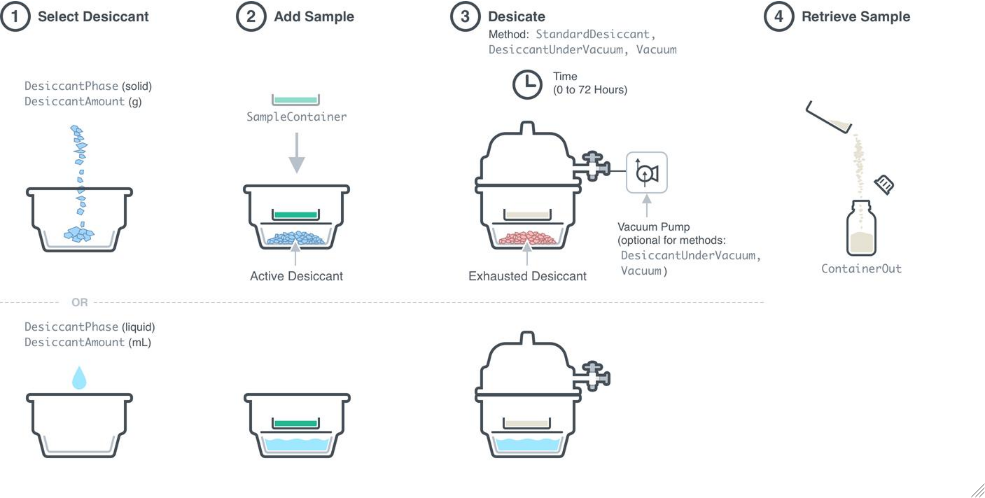
Figure 1.1: Procedural outline for ExperimentDesiccate. Step 1: Select a desiccator. The desiccator can be selected using "Desiccator" option. Refer to Table 1 for available desiccators and their specifications. The default desiccant is Indicating Drierite, Model[Sample, "Indicating Drierite"], with the flexibility to choose any solid or liquid chemical via "Desiccant" option. Step 2: Input sample specifications. "Amount" specifies the quantity of the input sample(s) for the experiment. Samples may either remain in their original container (for full sample usage) or be moved to a new container using "SampleContainer" option. Step 3: Desiccation. The desiccation method is determined by "Method" option. Available desiccation methods include StandardDesiccant, DesiccantUnderVacuum, and Vacuum. StandardDesiccant uses a chemical desiccant specified by the "Desiccant" option. DesiccantUnderVacuum uses a chemical desiccant within a vacuumed desiccator to improve drying efficiency. Vacuum, on the other hand, exposes the sample only to a vacuum within a bell jar desiccator, without the use of any desiccant. The duration of desiccation is determined by "Time" which can be set to any value under 72 hours with a default of 5 hours. Step 4: Retrieving samples: The experiment concludes with the retrieval and storage of the sample. "ContainerOut" determines the container that the sample is transferred into after desiccation. The storage conditions for the desiccated samples can be specified by "SamplesOutStorageCondition" option.
Instrumentation
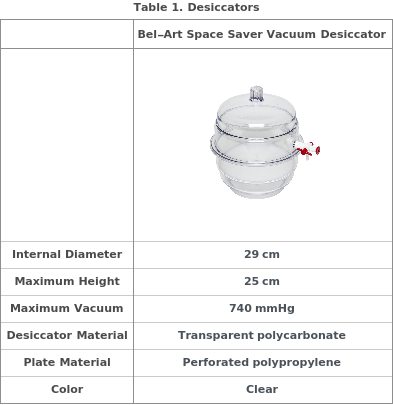
Bel-Art Space Saver Vacuum Desiccator

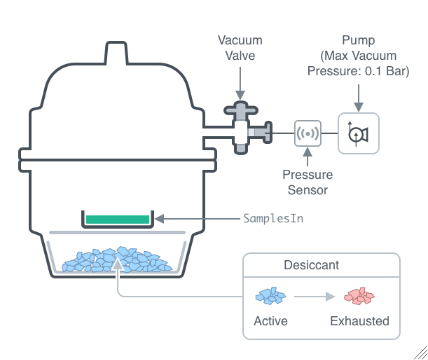
Figure 2.1.1: This diagram shows the bell jar desiccator at ECL. It is connected to a vacuum pump, and the pressure inside the chamber is monitored with a sensor during desiccation under vacuum. The desiccator uses Drierite as the default desiccant, which is blue when dry and turns pink as it absorbs moisture; however, any chemical can be specified as the desiccant.
Experiment Options
General
Amount
The mass of a sample to transfer from the input samples into a container before desiccation. If Amount is specified to a value other than All and SampleContainer is not informed, the specified Amount of the sample is transferred into a container before desiccation, determined by PreferredContainer function.
SampleContainer
The container that the sample Amount is transferred into prior to desiccating in a bell jar. The container's lid is off during desiccation.
Default Calculation: Automatically set to Null if Amount is set to All; otherwise, it is calculated by the PreferredContainer function. Null indicates that the sample is desiccated in its primary container without being transferred to another.
Pattern Description: An object of type or subtype Model[Container] or Object[Container] or a prepared sample or Null.
Programmatic Pattern: ((ObjectP[{Model[Container], Object[Container]}] | _String) | Automatic) | Null
Method
Method of drying the sample (removing water or solvent molecules from the solid sample). Options include StandardDesiccant, Vacuum, and DesiccantUnderVacuum. StandardDesiccant involves utilizing a sealed bell jar desiccator that exposes the sample to a chemical desiccant that absorbs water molecules from the exposed sample. DesiccantUnderVacuum is similar to StandardDesiccant but includes creating a vacuum inside the bell jar via pumping out the air by a vacuum pump. Vacuum just includes creating a vacuum by a vacuum pump and desiccant is NOT used inside the desiccator.
Desiccant
The hygroscopic chemical that is used in the desiccator to dry the exposed sample by absorbing water molecules from the sample.
Default Calculation: Automatically set to Model[Sample,"Indicating Drierite"], Model[Sample,"Sulfuric acid"], or Null if DesiccantPhase is Solid/not informed, Liquid, or Method is Vacuum.
Pattern Description: An object of type or subtype Model[Item, Consumable], Object[Item, Consumable], Model[Sample], or Object[Sample] or a prepared sample or Null.
Programmatic Pattern: ((ObjectP[{Model[Item, Consumable], Object[Item, Consumable], Model[Sample], Object[Sample]}] | _String) | Automatic) | Null
DesiccantPhase
The physical state of the desiccant in the desiccator which dries the exposed sample by absorbing water molecules from the sample.
Default Calculation: Automatically set to the physical state of the selected desiccant, or Null if Desiccant is Null.
DesiccantAmount
The mass of a solid or the volume of a liquid hygroscopic chemical that is used in the desiccator to dry the exposed sample by absorbing water molecules from the sample.
Default Calculation: Automatically set to 100 Gram if DesiccantPhase is Solid, 100 Milliliter if DesiccantPhase is Liquid, or Null if Method is Vacuum.
Pattern Description: Greater than or equal to 0 grams and less than or equal to 60 kilograms or greater than or equal to 0 milliliters and less than or equal to 20 liters or Null.
Programmatic Pattern: ((RangeP[0*Gram, $MaxTransferMass] | RangeP[0*Milliliter, $MaxTransferVolume]) | Automatic) | Null
Desiccator
The instrument that is used to dry the sample by exposing the sample with its container lid open in a bell jar which includes a chemical desiccant either at atmosphere or vacuum.
Pattern Description: An object of type or subtype Model[Instrument, Desiccator] or Object[Instrument, Desiccator]
Time
Storage Information
DesiccantStorageContainer
The desired container that the desiccant is transferred into after desiccation. If Not specified, it is determined by PreferredContainer function.
Pattern Description: An object of type or subtype Model[Container] or Object[Container] or a prepared sample or Null.
Programmatic Pattern: ((ObjectP[{Model[Container], Object[Container]}] | _String) | Automatic) | Null
ContainerOut
The desired container that the desiccated sample should be transferred into after desiccation. If specified, all of the sample is transferred into ContainerOut.
Pattern Description: An object of type or subtype Model[Container] or Object[Container] or a prepared sample or Null.
SamplesOutStorageCondition
The non-default conditions under which any new samples generated by this experiment should be stored after the protocol is completed. If left unset, the new samples will be stored according to their Models' DefaultStorageCondition.
Pattern Description: {AmbientStorage, Refrigerator, Freezer, DeepFreezer, CryogenicStorage, YeastIncubation, YeastShakingIncubation, BacterialIncubation, BacterialShakingIncubation, MammalianIncubation, ViralIncubation, CrystalIncubation, AcceleratedTesting, IntermediateTesting, LongTermTesting, UVVisLightTesting}, Desiccated, VacuumDesiccated, RefrigeratorDesiccated, or Disposal or an object of type or subtype Model[StorageCondition] or Null.
Sample Prep Options
Sample Preparation
PreparatoryUnitOperations
Specifies a sequence of transferring, aliquoting, consolidating, or mixing of new or existing samples before the main experiment. These prepared samples can be used in the main experiment by referencing their defined name. For more information, please reference the documentation for ExperimentSampleManipulation.
Pattern Description: List of one or more unit Operation ManualSamplePreparation or RoboticSamplePreparation or unit Operation must match SamplePreparationP entries or Null.
Programmatic Pattern: {((ManualSamplePreparationMethodP | RoboticSamplePreparationMethodP) | SamplePreparationP)..} | Null
PreparatoryPrimitives
Specifies a sequence of transferring, aliquoting, consolidating, or mixing of new or existing samples before the main experiment. These prepared samples can be used in the main experiment by referencing their defined name. For more information, please reference the documentation for ExperimentSampleManipulation.
Protocol Options
Organizational Information
Template
A template protocol whose methodology should be reproduced in running this experiment. Option values will be inherited from the template protocol, but can be individually overridden by directly specifying values for those options to this Experiment function.
Pattern Description: An object of type or subtype Object[Protocol] or an object of type or subtype of Object[Protocol] with UnresolvedOptions, ResolvedOptions specified or Null.
Programmatic Pattern: (ObjectP[Object[Protocol]] | FieldReferenceP[Object[Protocol], {UnresolvedOptions, ResolvedOptions}]) | Null
Name
A object name which should be used to refer to the output object in lieu of an automatically generated ID number.
Post Experiment
MeasureWeight
Indicates if any solid samples that are modified in the course of the experiment should have their weights measured and updated after running the experiment. Please note that public samples are weighed regardless of the value of this option.
MeasureVolume
Indicates if any liquid samples that are modified in the course of the experiment should have their volumes measured and updated after running the experiment. Please note that public samples are volume measured regardless of the value of this option.
ImageSample
Example Results
- The pressure of the desiccator chamber throughout the desiccation is saved to Pressure field of the protocol object:
ExperimentDesiccate[
Object[Sample,"Sample for ExperimentDesiccate help files"],
Desiccator -> Model[Instrument,Desiccator,"Bel-Art Space Saver Vacuum Desiccator"],
Time -> 5 Hour,
Method -> Vacuum,
Amount -> All
]
Object[Protocol,Desiccate,"id:pZx9joO8wjE0"]
Download[Object[Protocol,Desiccate,"id:pZx9joO8wjE0"], DesiccationImages]

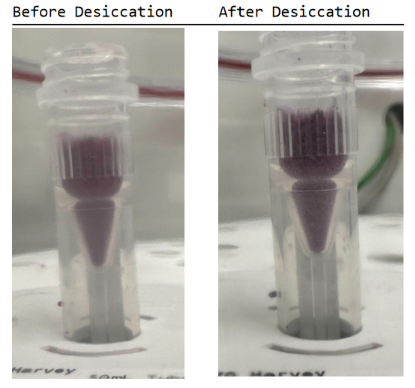
Download[Object[Protocol,Desiccate,"id:pZx9joO8wjE0"], Pressure]

PlotSensor[Object[Data,Pressure,"id:wqW9BPzWAkM4"]]
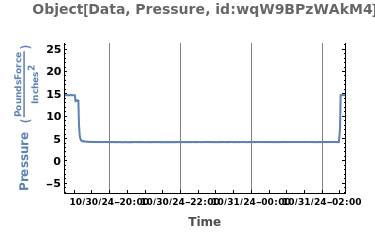
Warnings and Errors
Messages (10)
DesiccantPhaseAndAmountMismatch (1)
InsufficientDesiccantAmount (1)
InvalidSamplesOutStorageCondition (1)
MethodAndDesiccantPhaseMismatch (1)
MissingDesiccantAmount (1)
Possible Issues
Last modified on Sat 16 Nov 2024 23:53:28


































